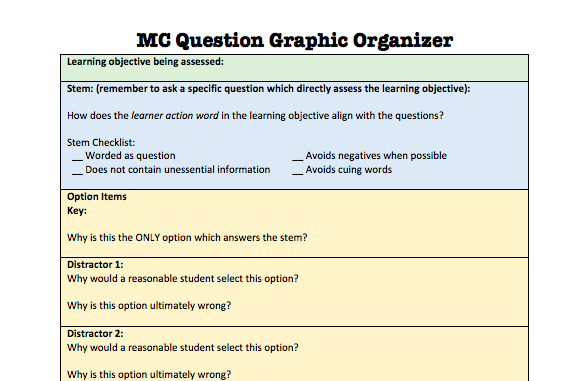
Multiple choice questions are here to stay. They are generally easy to give and they can get you lots data to analyze. But many educators and students hate multiple choice questions. There is something about the format which makes people think that it is a lower-level means of assessing student learning. Using multiple choice questions is seen as the “easy” way out. But while the format of a multiple choice question is less flexible than a constructed response, this actually means that quality multiple choice items are harder to write. And the data you can get from a well-constructed multiple choice item can actually be quite informative.
I use this simple graphic organizer to help faculty members write better multiple choice questions. Feel free to download it yourself. If you use it, you will find that your multiple choice questions will get much better. In fact, you might even find the rich data you get from multiple choice questions more informative than sifting endless pages of essays.

Here are a few key concepts and terms you might need to know to use the form.
Stem: The stem is the question part of the question. It should be to the point, but should always be a question. It should also include all necessary information so that the options can be very concise.
Learner Action Word: Think Bloom’s here. Are you asking the learner to do something that you have identified as a learning objective: define, recognize, evaluate, etc?
Options: Options are the choices that the student is given. (a., b., c., etc)
Key: This is the right answer.
Distractors: These are the wrong answers (interestingly enough they can be the hardest to come up with).
Cuing: Anything that makes the learner think that they are going to “beat” the test. The answer is always “c”, pick the longest answer, etc.
Parallelism: The simple idea that it is good to have like things. So for example, all options have a similar grammatical structure. Additionally, if you introduce one class of objects, adjectives, or verbs in an option, you should have another option which includes the same class.
For example: a red shoe, a blue hat, a purple table, and a yellow chair.
Here all of the options have colors, and the options are paired by clothing (shoe, hat) and furniture (table, chair). If we were to add a soccer ball to this list, it would stick out. There is no color and it is neither furniture, nor clothing. Even if it is not the right answer, it might cue the learner and cause them to answer in an inauthentic way.
Organizing Scheme: Once you have your key and distractors it is important to organize them in a way which does not cue the learner. There are a few ways to do this. For one word answers, it is best to go in alphabetical order, for quantitative answer go from smallest to largest, for multi-word options arrange them from the shortest worded to the longest. It is important to note, that we are very bad at being random, so if you do not pick a organizational scheme for your options, you will likely fall into patterns. Additionally, the asymmetry of randomly ordered options may cue the learner and cause them to answer in an inauthentic way.
And one more tip:
Justify everything!: Throughout the form you are asked to state the rationale for why you have made the choices that you have made. This is very important. It is very easy to get a little lazy when writing exam questions, having the discipline to carefully consider your choices will make all of the difference in your assessment.